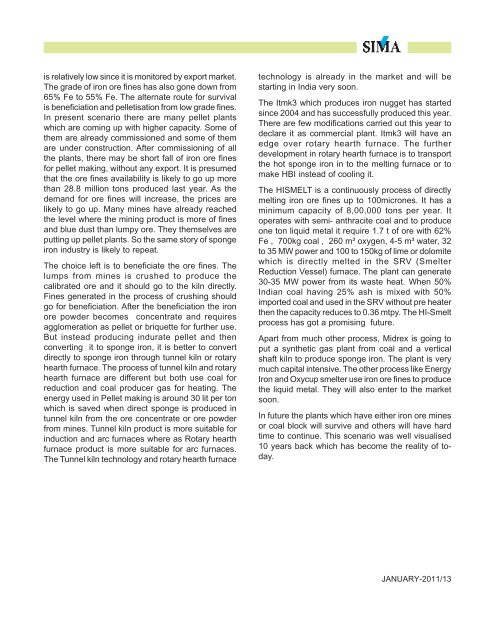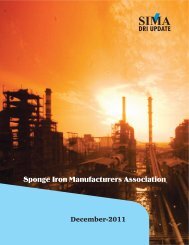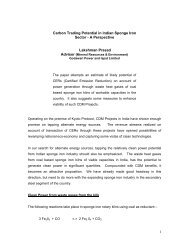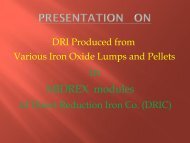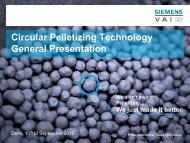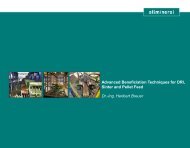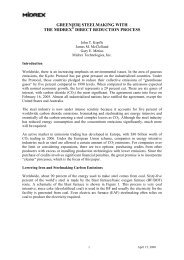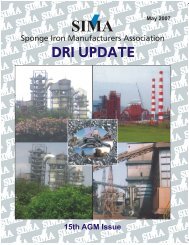sponge iron industry –past-present-future - SIMA
sponge iron industry –past-present-future - SIMA
sponge iron industry –past-present-future - SIMA
You also want an ePaper? Increase the reach of your titles
YUMPU automatically turns print PDFs into web optimized ePapers that Google loves.
is relatively low since it is monitored by export market.<br />
The grade of <strong>iron</strong> ore fines has also gone down from<br />
65% Fe to 55% Fe. The alternate route for survival<br />
is beneficiation and pelletisation from low grade fines.<br />
In <strong>present</strong> scenario there are many pellet plants<br />
which are coming up with higher capacity. Some of<br />
them are already commissioned and some of them<br />
are under construction. After commissioning of all<br />
the plants, there may be short fall of <strong>iron</strong> ore fines<br />
for pellet making, without any export. It is presumed<br />
that the ore fines availability is likely to go up more<br />
than 28.8 million tons produced last year. As the<br />
demand for ore fines will increase, the prices are<br />
likely to go up. Many mines have already reached<br />
the level where the mining product is more of fines<br />
and blue dust than lumpy ore. They themselves are<br />
putting up pellet plants. So the same story of <strong>sponge</strong><br />
<strong>iron</strong> <strong>industry</strong> is likely to repeat.<br />
The choice left is to beneficiate the ore fines. The<br />
lumps from mines is crushed to produce the<br />
calibrated ore and it should go to the kiln directly.<br />
Fines generated in the process of crushing should<br />
go for beneficiation. After the beneficiation the <strong>iron</strong><br />
ore powder becomes concentrate and requires<br />
agglomeration as pellet or briquette for further use.<br />
But instead producing indurate pellet and then<br />
converting it to <strong>sponge</strong> <strong>iron</strong>, it is better to convert<br />
directly to <strong>sponge</strong> <strong>iron</strong> through tunnel kiln or rotary<br />
hearth furnace. The process of tunnel kiln and rotary<br />
hearth furnace are different but both use coal for<br />
reduction and coal producer gas for heating. The<br />
energy used in Pellet making is around 30 lit per ton<br />
which is saved when direct <strong>sponge</strong> is produced in<br />
tunnel kiln from the ore concentrate or ore powder<br />
from mines. Tunnel kiln product is more suitable for<br />
induction and arc furnaces where as Rotary hearth<br />
furnace product is more suitable for arc furnaces.<br />
The Tunnel kiln technology and rotary hearth furnace<br />
technology is already in the market and will be<br />
starting in India very soon.<br />
The Itmk3 which produces <strong>iron</strong> nugget has started<br />
since 2004 and has successfully produced this year.<br />
There are few modifications carried out this year to<br />
declare it as commercial plant. Itmk3 will have an<br />
edge over rotary hearth furnace. The further<br />
development in rotary hearth furnace is to transport<br />
the hot <strong>sponge</strong> <strong>iron</strong> in to the melting furnace or to<br />
make HBI instead of cooling it.<br />
The HISMELT is a continuously process of directly<br />
melting <strong>iron</strong> ore fines up to 100micrones. It has a<br />
minimum capacity of 8,00,000 tons per year. It<br />
operates with semi- anthracite coal and to produce<br />
one ton liquid metal it require 1.7 t of ore with 62%<br />
Fe , 700kg coal , 260 m³ oxygen, 4-5 m³ water, 32<br />
to 35 MW power and 100 to 150kg of lime or dolomite<br />
which is directly melted in the SRV (Smelter<br />
Reduction Vessel) furnace. The plant can generate<br />
30-35 MW power from its waste heat. When 50%<br />
Indian coal having 25% ash is mixed with 50%<br />
imported coal and used in the SRV without pre heater<br />
then the capacity reduces to 0.36 mtpy. The HI-Smelt<br />
process has got a promising <strong>future</strong>.<br />
Apart from much other process, Midrex is going to<br />
put a synthetic gas plant from coal and a vertical<br />
shaft kiln to produce <strong>sponge</strong> <strong>iron</strong>. The plant is very<br />
much capital intensive. The other process like Energy<br />
Iron and Oxycup smelter use <strong>iron</strong> ore fines to produce<br />
the liquid metal. They will also enter to the market<br />
soon.<br />
In <strong>future</strong> the plants which have either <strong>iron</strong> ore mines<br />
or coal block will survive and others will have hard<br />
time to continue. This scenario was well visualised<br />
10 years back which has become the reality of today.<br />
JANUARY-2011/13


